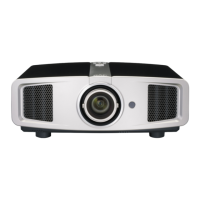only down to 0.001fL).
But unlike the Sharp, the JVC can de-
liver this low black level while set up for
a higher peak white output. In other
words, the JVC can be, simultaneously,
both brighter on bright scenes and
darker on dimmer ones than the Sharp.
In both respects the JVC is also slightly
superior to the Sony Pearl. And unlike
the Sony, it does not use a dynamic iris to
achieve those deep blacks.
Comparisons
Sharp: The black level capability of the
JVC is, indeed, directly competitive with
that of the $11,999 Sharp XV-Z20000
(which like the JVC does not have an
auto iris). Overall, however, the Sharp
XV-Z20000 still has the best combina-
tion of deep blacks and consistent scene-
to-scene contrast ratio I’ve yet seen on a
digital projector.
While the JVC could match or even
exceed the Sharp in its measured black
level and peak contrast ratio, and on
many scenes looked every bit as good,
there were some scenes in which the
prize clearly went to the Sharp. Blacks
could turn a little gray on the JVC in
scenes with dark foreground details and
strong backlighting. For example, in the
2005 King Kong there’s a sequence in
which Kong is rampaging in Times
Square just after breaking out of the the-
ater. In one shot, just over half the screen
is covered with Kong’s head and shoul-
ders, with a bright neon sign above and
behind him. On the Sharp, Kong’s fur re-
mains a dark gray, with its detailing still
evident. On the JVC, the fur is still nicely
detailed, but it’s a lighter, paler gray. In
another example from chapter 43 of the
same film, there’s a night shot of a New
York street as Ann Darrow (Naomi
Watts), backlit, walks slowly toward
Kong. It’s intercut with shots of the big
ape. Again, the Sharp looks a little more
dimensional in this scene, with better ap-
parent contrast.
Although the Sharp’s picture did”pop”
a little more realistically than the JVC’s,
the difference, more often than not, was
elusive. Comparative (not absolute)
measurements suggest that the Sharp has
superior ANSI contrast (which shows
how well the blacks and dark grays stay
dark in the presence of bright areas in the
image), but the JVC has better peak con-
trast (peak white output divided by the
level of video black). This might be one
explanation for the visible differences I
saw on some real program material, and
why those differences could come and
go on different scenes.
But at a shade over half the price of the
Sharp, the deep black and contrast ratio
performance of the JVC can only be de-
scribed as amazing.
On most program material, I also
found the JVC to be a hair sharper than
the Sharp. This was surprising, because
while both projectors clearly responded
to the 37.1MHz video burst on my Ac-
cuPel test pattern generator (tested in
HDMI), the response of the JVC at that
frequency was down a bit in level com-
pared to the Sharp.
There’s also the issue of rainbows. Like
all single chip DLP projectors, the Sharp
will occasionally show them. They
weren’t as distracting to me as on some
DLPs (and single-chip DLPs, in general,
are far better at suppressing rainbows
than in early DLP designs). But the
three-chip JVC will never flash a rain-
bow.
But on much of the program material
I watched I could switch back and forth
between the Sharp and the JVC and not
be able to make an easy, clear call as to
which I preferred. And when I did see a
difference worth commenting on, the far
less expensive JVC sometimes came out
on top. The more time I spent with the
JVC, the more excited I became at its
combination of performance and value.
Sony: In my First Look I concluded
by deduction that the JVC was sharper
than the Sony Pearl. No further need for
(elementary) deduction now; I was able
to spend the better part of a day directly
comparing the JVC to the Sony, using
ultimateAV
SPECIFICATIONS
Display panel/size: D-ILA device, 0.7”
(1920x1080 x 3)
Projection lens: 2.0x manual zoom
(zoom/focus manual)
Lamp: 200W Ultra-high pressure mer-
cury
Color System: NTSC, NTSC4.43, PAL,
PAL-M, PAL-N, SECAM
Analog video input format: 480i/p,
576i/p, 720p/50/60Hz, 1080i/50/60Hz
Digital video input format: 480i/p,
576i/p, 720p/50/60Hz, 1080i/50/60Hz,
1080p/24/50/60Hz, VGA 60Hz
Inputs: one each composite, S-Video
and component, two HDMI (HDCCP
compliant)
Power consumption: 280W (Standby:
2.8W)
Installation altitude: Below 5000ft
Weight: 25.5 lbs
Dimensions: 17.9” x 6.9” x 16.5”
(WxHxD, excluding lens and protru-
sion portion)
REVIEW SYSTEM
Sources
Toshiba HD-A1 and HD-XA2 HD DVD
players
Pioneer Elite BDP-HD1 Blu-ray player
Pioneer Elite DV-79AVi universal DVD
player NAD Masters Series M55 uni-
versal DVD player
AccuPel HDG-3000 test pattern gener-
ator
Video Cables
Ultralink and Monster HDMI
Tributaries component
Screen
Stewart Studiotek 130 (78” wide,
16:9, white, 1.3-gain)
Power conditioners
APC S15 (sources)
Audio Power Industries Power Wedge
VI (projectors)
Manufacturer
JVC Company of America
www.jvc.com
(973) 317-5000

